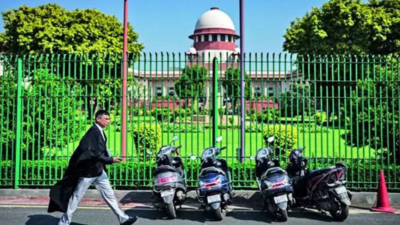NEW DELHI: The Supreme Court on Saturday directed the governments of Haryana, Uttar Pradesh and Rajasthan to pay compensation to the construction workers affected by the closure of activities due to Graded Response Action Plan in Delhi-NCR.
A bench of justices Abhay Oka and Ujjal Bhuyan held that governments must pay the workers using funds collected as labour cess, even if there is no specific court order.
“As far as 2024 and 2025 are concerned we have issued directions to the state to pay compensation. We make it clear that hereafter whenever the construction activities are required to be closed due to implementation of GRAP measures, compensation shall be paid to the affected workers in terms of directions issued by this court dated 24th November 2021,” the bench said.
“Even if there is no specific direction of the court to pay compensation, the NCR States shall pay compensation,” it added.
During the hearing the apex court was informed that Haryana, in the first and second phases of GRAP-4, has paid compensation to 2,68,759 and 2,24,881 workers, respectively.
Additionally, the process of paying compensation to around 95,000 workers for the January 2025 GRAP 4 period is underway.
Rajasthan government disclosed that compensation had been paid to 3,197 workers, while Uttar Pradesh informed that compensation had been disbursed to 4,88,246, 4,84,157, and 691 workers affected during phases 1, 2, and 3 of GRAP, respectively.
The counsel for the Delhi government told the court that compensation had been paid to 93,272 workers and the verification process for the remaining registered workers is in progress.
This comes after the court reprimanded Delhi government for not paying the full subsistence allowance to construction workers, who went without work due to the curbs imposed to combat air pollution in the national capital.
The Delhi government was directed to convene a meeting of the workers’ union immediately to ensure their registration.
Anti-pollution curbs include a ban on all construction activities, entry of non-essential polluting trucks into Delhi, and mandatory shifting of school classes, except for classes 10 and 12, to hybrid mode.
During winters, the Delhi-NCR region enforces restrictions under GRAP, which categorizes air quality into four stages – Stage 1 (Poor, AQI 201-300), Stage 2 (Very Poor, AQI 301-400), Stage 3 (Severe, AQI 401-450), and Stage 4 (Severe Plus, AQI above 450).
Unfavourable meteorological conditions, combined with vehicle emissions, paddy-straw burning, firecrackers, and other local pollution sources, lead to hazardous air quality levels in Delhi-NCR during winters.




